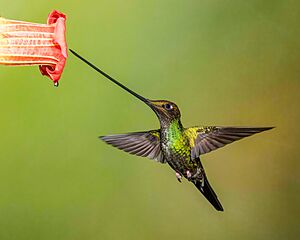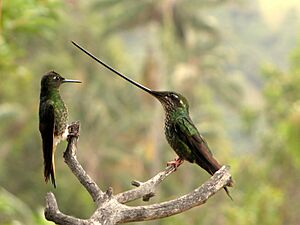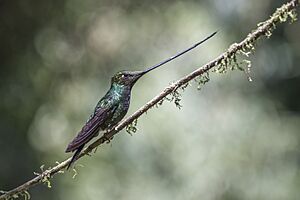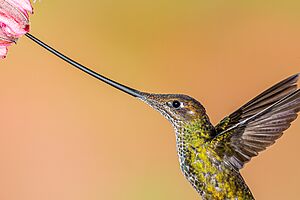Sword-billed hummingbird facts for kids
Quick facts for kids Sword-billed hummingbird |
|
|---|---|
 |
|
| Male | |
 |
|
| Female sword-billed hummingbird (right) with a buff-tailed coronet
|
|
| Conservation status | |
| Scientific classification | |
| Genus: |
Ensifera (bird)
|
| Species: |
ensifera
|
 |
|
| Distribution range of the sword-billed hummingbird | |
| Synonyms | |
|
Ornismya ensifera Boissonneau, 1840 |
|
The sword-billed hummingbird (Ensifera ensifera) is a special bird from the Andes mountains in South America. It is also called the swordbill. This hummingbird is the only species in its group, called the genus Ensifera.
It's one of the biggest hummingbirds around. What makes it super unique is its incredibly long bill. It's the only bird in the world with a bill longer than its whole body, not counting its tail! The sword-billed hummingbird uses its long bill to drink nectar from flowers that have deep, tube-like petals. It has even grown together with a specific flower, Passiflora mixta.
Most birds use their bills to clean their feathers, but the sword-billed hummingbird can't. Its bill is too long! So, it uses its feet to scratch and tidy its feathers instead. This bird is a "trap-line feeder," meaning it visits the same flowers in a regular order. It also catches insects while flying.
The sword-billed hummingbird builds cup-shaped nests from moss. It is currently listed as a species of "least concern" by the International Union for Conservation of Nature (IUCN). However, it faces threats from climate change and deforestation.
Contents
About the Sword-Billed Hummingbird
The sword-billed hummingbird was first described in 1839. This was done by a person named Auguste Boissonneau. He called it Ornismya ensifera. Later, in 1843, René Lesson moved it to its own group, the genus Ensifera.
The name ensifera comes from Latin words. Ensis means "sword" and ferre means "to carry." So, Ensifera means "sword-wielder," which perfectly describes this bird's long bill! The official name for this bird is the sword-billed hummingbird.
This bird is the only species in its group, Ensifera. This means it's a one-of-a-kind bird in its genus.
What Does a Sword-Billed Hummingbird Look Like?
The sword-billed hummingbird is one of the largest hummingbirds. Adults are about 13 to 14 centimeters (5 to 5.5 inches) long. This measurement does not include their bill. They weigh about 10 to 15 grams (0.35 to 0.53 ounces). Males are usually a bit bigger than females.
The most amazing part of this bird is its huge bill. It can be 8 to 12 centimeters (3 to 4.7 inches) long! This bill is the longest of any hummingbird. It is also the longest bill compared to the body size of any bird on Earth.
Male and female sword-billed hummingbirds look a bit different. This is called sexual dimorphism. Males have shorter bills but longer wings and tails. Their upper parts are bronze-green. Their heads are coppery-bronze. They have a small white spot behind each eye. Their throats are dusky, and their underparts are metallic green. Their belly is dark gray, and their tail is forked and blackish bronze-green. Some males might have white on their chin and throat.
Females have similar upper parts. But their underparts are white. Their throats and bellies are grayish with green speckles. Their tail is not as deeply forked. It also has grayish-white edges. Young birds look similar to the females.
The sword-billed hummingbird's bill is black, heavy, and slightly curved upwards. This super long bill helps the bird reach nectar. It can get nectar from flowers with long, tube-like petals. Other birds cannot reach this nectar.
Bird Sounds: What Does It Say?
The sword-billed hummingbird makes a low, rumbling sound. It's a bit like a trilled "trrr."
Where Do Sword-Billed Hummingbirds Live?
The sword-billed hummingbird lives in the Andes mountains. You can find it from western Venezuela through Colombia, Ecuador, and Peru all the way to Bolivia.
It likes to live in humid and wet mountain forests. It also lives at the edges of forests, in bushy areas, and in gardens. Sometimes, it can be found in high grasslands called páramo. These places are usually at elevations of 1,700 to 3,500 meters (5,600 to 11,500 feet). They are most common between 2,400 and 3,100 meters (7,900 and 10,200 feet).
These birds usually do not move around much. They are non-migratory. But in Colombia and northwestern Venezuela, they might move to higher places during the early wet season. Then they return to lower areas in the dry season.
The places where sword-billed hummingbirds live match where certain Passiflora (passionflower) species grow. This is because of their very special bill and how they eat.
How Sword-Billed Hummingbirds Live
Like all hummingbirds, the sword-billed hummingbird can fly backward. It can also hover in the air. This means it can stay in one spot while flying.
Diet and Feeding Habits
The sword-billed hummingbird is a specialist feeder. This means it mostly eats certain types of food. It mainly feeds on nectar from flowers with long, tube-like petals. These include Brugmansia sanguinea, Datura stramonium, and different types of passionflowers like Passiflora mixta. It also feeds from flowers in other plant groups such as Fuchsia and Solanum.
When it feeds, it pokes its long bill into the flower from below. It is a "trap-line feeder." This means it visits a specific set of flowers in the same order again and again. It also catches insects while flying. It does this by keeping its bill open as it flies.
Perching and Preening
When the sword-billed hummingbird rests, it points its bill upwards. This helps it balance its heavy beak. It also reduces strain on its neck.
Because its bill is so long, the bird has to use its feet to clean its feathers. This is called preening. Even though it takes longer than using a beak, preening is important. It helps remove tiny bugs from its feathers. It also spreads oil to keep the feathers healthy.
Reproduction and Life Cycle
Sword-billed hummingbirds usually breed from February to March. Their nests are shaped like a cup. They are made of moss. These nests are often hung among plant roots high above the ground.
A Special Partnership with Passiflora mixta
The sword-billed hummingbird has a very special relationship with the Passiflora mixta passionflower. This is called coevolution. It means the bird and the flower have evolved together over a long time.
The flower's parts, like its pollen holders and sticky tips, are placed in a way that only the sword-billed hummingbird can reach them. The flower's nectar tube is also just the right length for the bird's bill. This special partnership is a mutualistic relationship. The flower depends on the bird for pollination. In return, the bird gets a great food source.
To get nectar, the hummingbird puts its long bill down the flower's tube. The bill and the tube are almost the same length! It drinks, then hovers for a few seconds, and repeats. Other creatures, like insects, might get nectar by making a hole at the base of the flower. They don't use the main tube.
Both the bird and the flower live in the same areas in the Andes mountains. This is more proof of their special coevolution. If the number of sword-billed hummingbirds went down, it would likely harm the P. mixta flowers.
Protecting the Sword-Billed Hummingbird
The sword-billed hummingbird is listed as a species of "least concern" by the International Union for Conservation of Nature (IUCN). This is because it lives in a large area. Its population is not dropping quickly. There are also no major threats right now.
It's hard to count how many of these birds exist globally. This is because they live in such a wide area and are not seen very often. The good news is that they have learned to live in some areas changed by humans. They also live in several protected areas.
However, climate change and deforestation are big worries. These could cause the birds to lose their homes. They could also lose their food sources, especially the Passiflora mixta flowers.
Sword-Billed Hummingbirds in Media
The famous BBC documentary series Planet Earth II showed the sword-billed hummingbird. It was featured flying through the forest in the episode called "Jungles."





